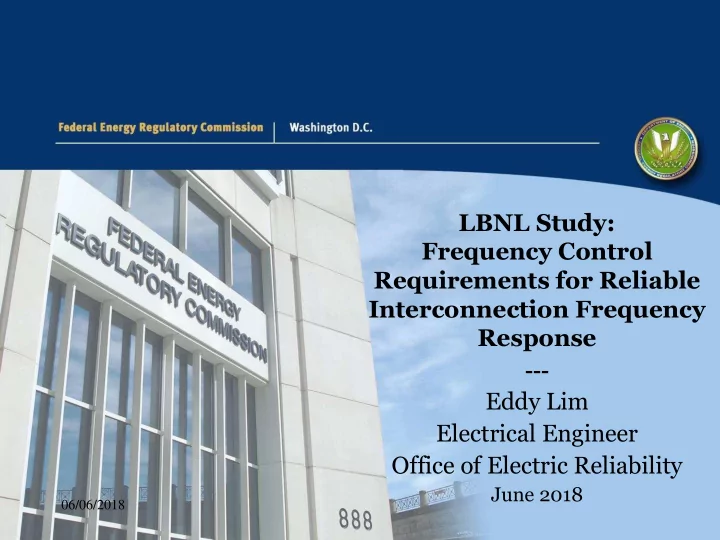

LBNL Study: Frequency Control Requirements for Reliable Interconnection Frequency Response --- Eddy Lim Electrical Engineer Office of Electric Reliability June 2018 06/06/2018 1
Disclaimer This report was prepared by Lawrence Berkeley National Laboratory for the Office of Electric Reliability. This report does not necessarily reflect the views of the Commission. 2
Objective • To assess and identify the key parameters of frequency control in response to a sudden loss of generation or load on the bulk power system. – Head Room, speed of response, sustained response, inertia, dead band, load response, frequency bias of plant controllers, size of the interconnection, size of the generation loss – Rate of change of frequency, nadir and settling frequency 3
Physical Requirements for Arresting Frequency Frequency is arrested when the amount of primary frequency response delivered equals the amount of generation lost Reserves held to provide primary frequency control must exceed the expected loss of generation 4
The Importance of Sustained Primary Frequency Response Failure to sustain sufficient primary frequency response will trigger UFLS Primary frequency response must be sustained until secondary frequency Unsustained Primary Frequency response can replace it Response can result in triggering UFLS 5
Key Study Findings Rapidly deployed and then sustained primary control action in response to the sudden loss of generation is a fundamental reliability requirement. This requirement is met by the action of turbine governors and, in some cases, by fast demand response. Generation interconnection policies should determine: • The extent to which the fleet is equipped to provide primary frequency response Generation dispatch policies should determine: • The required amount of primary frequency response – …which depends on the size of the generation loss event the interconnection is designed to withstand The required rate of delivery of primary frequency response • – …which depends on the inertia of the interconnection 6
Study Recommendations • Focused attention needed on the collection, maintenance, and validation of operating data and study models • International practices should be reviewed as options for U.S. grid operators to consider for adoption/adaptation • All generators should have the capability to provide sustained primary frequency response • Ensuring plant load controls don’t withdraw frequency response • The contributions of non-traditional resources for primary frequency control should be studied and incorporated, as appropriate, into future operations • The changing composition of loads should be studied and addressed 7
LBNL Study: Frequency Control Requirements for Reliable Interconnection Frequency Response https://www.ferc.gov/industries/ electric/indus-act/reliability.asp Contact: Eddy Lim FERC - Office of Electric Reliability Division of Engineering Planning and Operations 202.502.6713 Eddy.Lim@ferc.gov 8
Recommend
More recommend